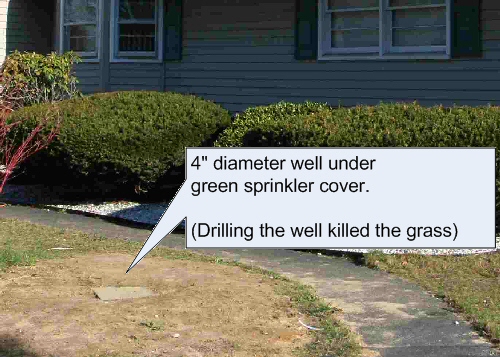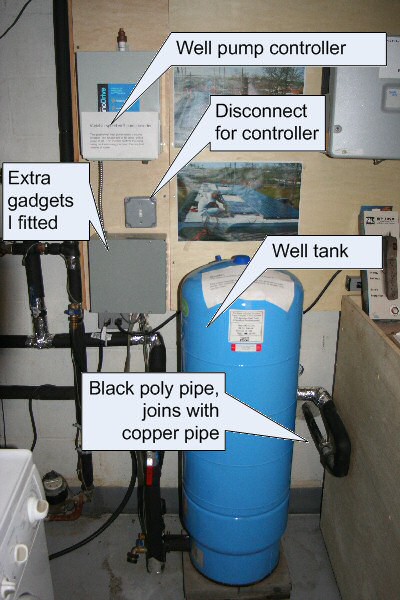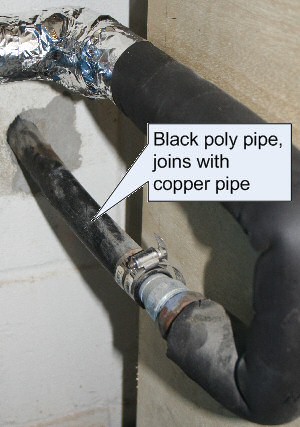Navigation:
Copyright © 2008,
Mark Bartosik & Swati Srivastava
Under construction. If you have questions, please
email us and we will not only answer your question, but add an explaination to this site.
Well installation

-
We have two wells. The source well (on the right) is 56' deep, the diffusion well is about 35' deep located about 70' to the
left. The wells have a 4" diameter casing.
There is a submersible well pump with a 3/4 HP 230v 3-phase motor (a 1/2 HP would have been a little more efficient) and a 15 GPM pump (a 10 GPM
pump head would have been a little more efficient). The well pump is driven by a Franklin Monodrive variable well
pump controller.
-
The well system was installed by:
Country Well Drilling,
Holtsville,
NY 11742.
(631) 289-1655
(631) 289-1678 (fax)
In 2006 the well system cost us $7000,
We think that they did a good job, and recommend them.
However, please read below to ensure the best possible install
Costs for wells vary by a number of factors, like depth, number of wells, diameter, geology, location/local economy, whether
or not you have a variable speed drive, pump size, supply and demand.
|
Getting the best installation

- Agree with the well driller the location of the wells
-
The well might only be 4" diameter, but a drilling rig is a
huge and heavy piece of construction equipment that will leave tracks in
your lawn and may crush sprinkler lines. Expect some dead grass.
- So that the wells can be easily located ask for a green sprinkler
cover to be placed over each well. If you don't want the green sprinkler
covers in your lawn then at least make sure that you have accurate maps of the
well locations.
- Agree with the well driller exactly where the well pump controller and
well tank will be located. They should not
obstruct access to electric panels or equipment in violation of NEC
(National Electrical Code), there must be a disconnect switch and clear
unobstructed access to the equipment.
|

- Agree where the pipes from the source well and the return well will penetrate into your house.
-
Polyethylene piping should not be used inside.
The well driller will likely use buried polyethylene piping (landscaping
/ sprinkler pipe) between the well and your house. This is great for underground installation, but should not
extend more than a couple of feet into the house. Just sufficient to
join to either copper or white PVC piping. Black polyethylene pipe is too
easy to damage compared with white PVC or copper pipe.
- Excessive pressure - don't pour money down a hole in the ground.
For most heat pumps you need no more than 25PSI of water pressure. Higher pressure than necessary will waste energy.
The well driller may have traditionally installed
drinking water wells. For domestic water supply you typically want about 50
PSI of pressure. However, for a heat pump you only want "just enough"
pressure. That is just enough to push the desired GPM through the heat pump.
For our 5 ton unit that is 24 PSI, for a friend's 4 ton unit it is 20 PSI, so
We guess it is about 4 PSI + 4 PSI per ton. On
the last day get the well driller and the heat pump installer to adjust the
pressure so that there is just enough pressure to reach the desired GPM
value, this requires some coordination between them. If the system runs at a
higher pressure you are literally squirting energy (and thus money) down a
hole in the ground. Again the well driller may not be aware of this, and
unless told may size the system to provide 50 PSI.
-
Effects of iron in the water
Ground water contains minerals, often including iron. When iron is exposed to oxygen in the air it oxidises forming rust
which could over time clog the diffusion well. To avoid this risk you can ask the well installer to install a
pitless-adapter in the diffusion well with a 1" PVC discharge pipe that reaches down below the ground water level. This way
from the point the water is drawn from the source well to the point it is returned back to the water table via the diffusion
well it never comes into contact with the air. This cost us about $200 extra.
|
Variable speed verses fixed speed well pumps.
- Fixed speed controllers are cheap and simple they control
single phase 115v or 230v motors by switching them on and off. There are two
pressure switches the lower one is set at the minimum pressure to achieve the desired GPM value. The upper value is
typically 20 PSI above this, any less and the motor will switch on and off
to frequently. The well pump runs until the upper pressure is reached,
and then it switches off and the bladder in the well tank contracts
until the lower pressure is reached when the motor switches on again.
For our system we would need to set the lower limit to 24 PSI and the
upper to 44 PSI (and average of 34 PSI).
- Variable speed controllers are more sophisticated, they control 3
phase 230v motors which are more efficient than 115v single phase motors.
A variable speed controller continuously
regulates the supply to the motor to maintain the
pressure much more precisely, gradually speeding up and slowing down the
motor. The pressure will vary very little.
We have found one serious problem with our Franklin Monodrive controller,
it uses about 40 watts on standby, when the well pump is NOT operating.
This is enough to completely negate any efficiency savings of using a variable speed controller!
It could be that other well controllers are more efficient, but unfortunately phantom or standby power consumption
is not usually listed in the user manual.
If the well pump runs for 1000 hours a year, then the wasted energy due to phantom
load is 40w * (24*365-1000) / 1000 = 310KWh (at $0.20/KWh that's $62 per year).
This is simply unacceptable to us. Our solution to this
was install a relay in the box below the controller labeled
"Extra gadgets" (see the picture above).
All that's needed is a double pole relay with contacts rated for 15A or 20A at 240vac and a 24vac coil.
The coil is activated by Y1 wire from the heat pump.
The power to the well pump controller is switched by the relay, it must be on a separate 15 or 20A breaker to the
heat pump and the breaker must not exceed the contact rating of the relay.
If you don't understand this, don't worry, show this
to your electrician or competant HVAC installer who should be able to wire this up for you.
If they don't want to wire things up this way, find someone else to do the job.
|
